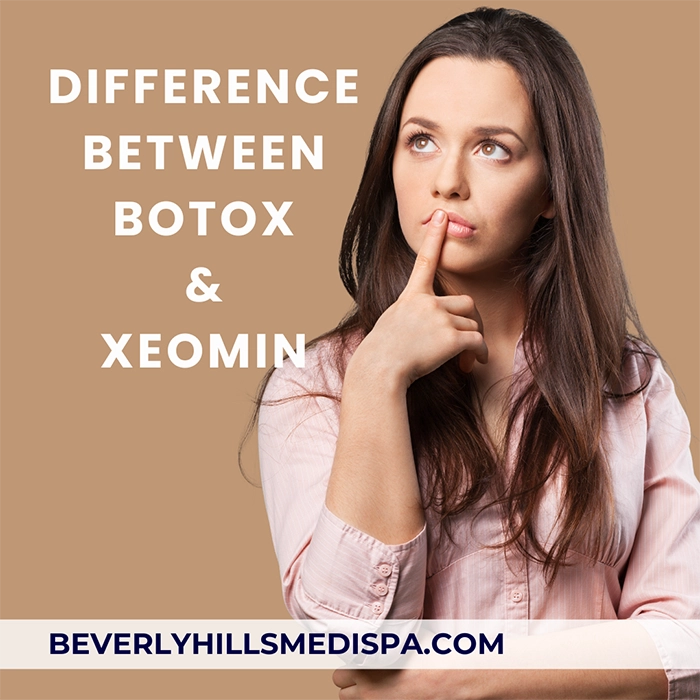Difference Between Botox and Xeomin

Difference Between Botox and Xeomin
Understanding the Difference Between Botox and Xeomin
As the world of cosmetic treatments advances, Botox and Xeomin stand at the forefront of non-surgical solutions to combat the signs of aging.
Known for their efficacy in reducing the appearance of fine lines and wrinkles, these two FDA-approved treatments have revolutionized how we approach anti-aging procedures. However, understanding the nuances that distinguish them is critical in guiding potential clients toward the most suitable treatment option despite their similar uses.
Botox and Xeomin in West Palm Beach Gardens, Florida, An Overview:
Botox, also known as OnabotulinumtoxinA, has been a household name in aesthetic medicine since its FDA approval in 2002. This treatment quickly became synonymous with non-surgical wrinkle relaxation, offering a minimally invasive solution to softening facial lines.
A newer addition to the market, Xeomin, or IncobotulinumtoxinA, received FDA approval in 2011. Despite its relatively recent introduction, Xeomin has shown a robust performance, rivaling its predecessor in efficacy and safety.
Botox and Xeomin are classified as neurotoxins or neuromodulators. They function by inhibiting the transmission of nerve signals to facial muscles, thereby causing muscle relaxation.
This reduction in muscle contraction results in the softening of dynamic wrinkles — those facial lines caused by repetitive muscle movements such as squinting or frowning.
Shared Characteristics
Botox and Xeomin have the same active ingredient, botulinum toxin type A.
The onset of their effects is comparable, with visible changes typically occurring within 3-7 days post-administration. These treatments offer temporary relief from wrinkles, with the effects generally lasting about 3-4 months, although this can vary from person to person.
The administration of both treatments involves injecting small amounts into specific facial muscles.
Key Distinctions
The fundamental differences between Botox and Xeomin lie in their respective formulations.
Botox contains additional proteins enveloping the core botulinum toxin, while Xeomin is stripped of these ancillary proteins, earning it the ‘naked’ neurotoxin moniker. This distinction in composition impacts how the body interacts with the treatments.
A few patients receiving Botox have been found to develop resistance over time due to the formation of antibodies that target the supplementary proteins. Conversely, Xeomin, devoid of these proteins, presents a theoretically lower risk of provoking an antibody response, reducing the chances of treatment resistance.
The absence of proteins in Xeomin also translates to practical benefits, such as not requiring refrigeration before use. This simplifies storage and handling procedures for clinics.
Another important difference pertains to the treatments’ diffusion properties. Some practitioners suggest that Botox might diffuse more extensively than Xeomin, affecting a wider area around the injection site.
Depending on the specific treatment area and desired outcomes, this could be beneficial or disadvantageous.
Choosing the Right Treatment
The choice between Botox and Xeomin often hinges on individual preferences and past experiences, both for the provider and the patient.
Some clients might opt for Xeomin due to its ‘cleaner’ formulation, while others might lean towards Botox if it has proven effective for them previously. A transparent discussion with a healthcare provider who can assess individual aesthetic goals, medical history, and potential risk factors is vital before deciding on a treatment plan.
In Conclusion
Whether it’s Botox or Xeomin, these neurotoxins can deliver superb results when administered by a proficient and experienced provider.
They are the epitome of advancements in aesthetic medicine, providing individuals with minimally invasive ways to preserve a youthful appearance. Although Botox and Xeomin share many similarities, the subtle differences can help prospective clients make an informed decision.
Ultimately, professional consultation is key to achieving satisfactory results from these treatments.
If you have any questions about these medications, don’t hesitate to contact us at (561)318-5367.
Dr. Dahabra and his Beverly Hills Wellness Center & Med Spa team in West Palm Beach Gardens are eager to be your medical cosmetic consultants and advocates.
